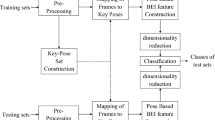Abstract
Gait can be easily acquired at a distance, so it has become a popular biometric especially in intelligent visual surveillance. In gait-based human identification there are many factors that may degrade the performance, and noise on human contours is a significant one because to extract contours perfectly is a hard problem especially in a complex background. The contours extracted from video sequences are often polluted by noise. To improve the performance, we have to reduce the effect of noise. Different from the methods which use dynamic time warping (DTW) in previous work to match sequences in the time domain, a DTW-based contour similarity measure in the spatial domain is proposed to reduce the effect of noise. The experiments on a large gait database show the effectiveness of the proposed method.
Chapter PDF
Similar content being viewed by others
Keywords
These keywords were added by machine and not by the authors. This process is experimental and the keywords may be updated as the learning algorithm improves.
References
Johnson, A.Y., Bobick, A.F.: A multi-view method for gait recognition using static body parameters. In: Bigun, J., Smeraldi, F. (eds.) AVBPA 2001. LNCS, vol. 2091, pp. 301–311. Springer, Heidelberg (2001)
Wang, L., Ning, H., Tan, T., Hu, W.: Fusion of static and dynamic body biometrics for gait recognition. IEEE Transactions on Circuits and Systems for Video Technology 14(2), 149–158 (2004)
Yam, C.Y., Nixon, M.S., Carter, J.N.: On the relationship of human walking and running: automatic person identification by gait. In: Proc. of International Conference on Pattern Recognition, Quebec, Canada, pp. 287–290 (2002)
Mowbray, S.D., Nixon, M.S.: Automatic gait recognition via fourier descriptors of deformable objects. In: Kittler, J., Nixon, M.S. (eds.) AVBPA 2003. LNCS, vol. 2688, pp. 566–573. Springer, Heidelberg (2003)
Wang, L., Tan, T., Ning, H., Hu, W.: Silhouette analysis-based gait recognition for human identification. IEEE Transactions on Pattern Analysis and Machine Intelligence 25(12), 1505–1518 (2003)
Niyogi, S.A., Adelson, E.H.: Analyzing and recognizing walking figures in xyt. In: CVPR, pp. 469–474. IEEE Computer Society Press, Los Alamitos (1994)
Yu, S., Wang, L., Hu, W., Tan, T.: Gait analysis for human identification in frequency domain. In: Proc. of the 3rd International Conference on Image and Graphics, Hong Kong, China, pp. 282–285 (December 2004)
Lam, T.H.W., Lee, R.S.T.: Human identification by using the motion and static characteristic of gait. In: ICPR, pp. 996–999. IEEE Computer Society Press, Los Alamitos (2006)
Cuntoor, N., Kale, A., Chellappa, R.: Combining multiple evidences for gait recognition. In: Proc. of the International Conference on Acoustics Speech and Signal Processing, Hong Kong (cancelled), April 6-10, 2003, vol. III, pp. 113–116 (2003)
Boulgouris, N.V., Plataniotis, K.N., Hatzinakos, D.: Gait recognition using dynamic time warping. In: Proc. of the 6th IEEE workshop on multimedia signal processing, BC, Canada, pp. 263–266. IEEE Computer Society Press, Los Alamitos (2004)
Pandey, N., Abdulla, W., Salcic, Z.: Human identification using vector quantisation technique. In: Proceedings of the Eighth International Symposium on Signal Processing and Its Applications, Sydney, Australia, pp. 671–674 (August 2005)
Veeraraghavan, A., Member, S., Roy-Chowdhury, A.K., Chellappa, R.: Matching shape sequences in video with applications in human movement analysis. IEEE Transactions on Pattern Analysis and Machine Intelligence 27(12), 1896–1909 (2005)
Yu, S., Tan, D., Tan, T.: A framework for evaluating the effect of view angle, clothing and carrying condition on gait recognition. In: ICPR 2006. Proc. of the 18’th International Conference on Pattern Recognition, Hong Kong, China, pp. 441–444 (August 2006)
Sarkar, S., Phillips, P.J., Liu, Z., Vega, I.R., Grother, P., Bowyer, k.W.: The humanid gait challenge problem: Data sets, performance, and analysis. IEEE Transactions on Pattern Analysis and Machine Intelligence 27(2), 162–177 (2005)
Kruskal, L.: The symmetric time-warping problem: From continuous to discrete. In: Sankoff, D., Kruskal, J.B. (eds.) Time Warps, String Edits, and Macromolecules: The Theory and Practice of Sequence Comparison, Addison-Wesley, Reading (1983)
Veeraraghavan, A., Chellappa, R., Roy-Chowdhury, A.K.: The function space of an activity. In: CVPR 2006. Proceedings of the 2006 IEEE Computer Society Conference on Computer Vision and Pattern Recognition, New York, USA, pp. 959–968. IEEE Computer Society Press, Los Alamitos (2006)
Keogh, E.J., Pazzani, M.J.: Derivative dynamic time warping. In: Proc. of the First SIAM International Conference on Data Mining, Chicago, USA, pp. 285–289 (April 2001)
Yu, S., Tan, D., Tan, T.: Modelling the effect of view angle variation on appearance-based gait recognition. In: Proc. of the 7th Asian Conference on Computer Vision, Hyderabad, India, pp. 807–816 (January 2006)
Author information
Authors and Affiliations
Editor information
Rights and permissions
Copyright information
© 2007 Springer-Verlag Berlin Heidelberg
About this paper
Cite this paper
Yu, S., Tan, D., Huang, K., Tan, T. (2007). Reducing the Effect of Noise on Human Contour in Gait Recognition. In: Lee, SW., Li, S.Z. (eds) Advances in Biometrics. ICB 2007. Lecture Notes in Computer Science, vol 4642. Springer, Berlin, Heidelberg. https://doi.org/10.1007/978-3-540-74549-5_36
Download citation
DOI: https://doi.org/10.1007/978-3-540-74549-5_36
Publisher Name: Springer, Berlin, Heidelberg
Print ISBN: 978-3-540-74548-8
Online ISBN: 978-3-540-74549-5
eBook Packages: Computer ScienceComputer Science (R0)





